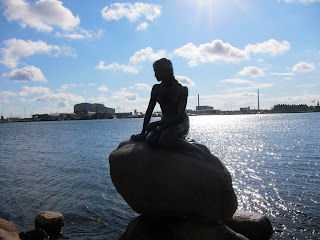
 The Danes are, overwhelmingly, a happy bunch. In fact, if you believe those contentment surveys that come out every couple of years, Denmark is one of the happiest nations on earth with some of the best quality of life. Along winding cobbled streets Danes shop and dine at some of the most exciting places in Europe. Copenhagen’s restaurants have more Michelin stars than any other Scandinavian city, and Denmark as a whole would doubtless have more still if the inspectors from Michelin ever troubled themselves to leave the capital and head for Aalborg or Århus & around. Even standards in a workaday Danish café are generally very high.
The Danes are, overwhelmingly, a happy bunch. In fact, if you believe those contentment surveys that come out every couple of years, Denmark is one of the happiest nations on earth with some of the best quality of life. Along winding cobbled streets Danes shop and dine at some of the most exciting places in Europe. Copenhagen’s restaurants have more Michelin stars than any other Scandinavian city, and Denmark as a whole would doubtless have more still if the inspectors from Michelin ever troubled themselves to leave the capital and head for Aalborg or Århus & around. Even standards in a workaday Danish café are generally very high. Beyond the capital and the bigger cities, Denmark offers a mix of lively towns such as Ribe and Odense plus rural countryside, medieval churches, Renaissance castles and tidy 18th-century villages. Neolithic dolmen, preserved 2000-year-old ‘bog people’, and impressive Viking ruins are just some of the remnants of the nation’s long and fascinating history.
Beyond the capital and the bigger cities, Denmark offers a mix of lively towns such as Ribe and Odense plus rural countryside, medieval churches, Renaissance castles and tidy 18th-century villages. Neolithic dolmen, preserved 2000-year-old ‘bog people’, and impressive Viking ruins are just some of the remnants of the nation’s long and fascinating history.
 Denmark continues to stamp its effortlessly cool style on the world with its furniture, fashion, architecture and graphic design, as it has done for the last half-century or so. This obsession with good design, detail and fine craftsmanship is evident even in something as mundane as a Copenhagen metro or train ride. Centuries on from the Viking era, Denmark remains very much a maritime nation, bordered by the Baltic and the North Sea. No place in the country is more than an hour’s drive from its lovely seashore, much of which is lined with splendid white-sand beaches. Denmark’s hydrocarbon-rich economy is booming; it has the highest per capita GDP in the European Union (EU); literacy is 100%; unemployment is low; and its social-welfare programmes are the envy of continents.
Denmark continues to stamp its effortlessly cool style on the world with its furniture, fashion, architecture and graphic design, as it has done for the last half-century or so. This obsession with good design, detail and fine craftsmanship is evident even in something as mundane as a Copenhagen metro or train ride. Centuries on from the Viking era, Denmark remains very much a maritime nation, bordered by the Baltic and the North Sea. No place in the country is more than an hour’s drive from its lovely seashore, much of which is lined with splendid white-sand beaches. Denmark’s hydrocarbon-rich economy is booming; it has the highest per capita GDP in the European Union (EU); literacy is 100%; unemployment is low; and its social-welfare programmes are the envy of continents.  Education is free, and about half of all Danish students who graduate from secondary school continue on to higher education.You don’t need statistics to understand the Dane’s happy lot, though. Stroll around Copenhagen or pretty much any Danish town and you’ll experience some of the most harmonious civic spaces anywhere. The capital’s intimate scale and faultless transport systems combine with the ornate history and bold modern lines of the built environment to delight the eye, while the locals’ courtesy and sense of humour is refreshing.
Education is free, and about half of all Danish students who graduate from secondary school continue on to higher education.You don’t need statistics to understand the Dane’s happy lot, though. Stroll around Copenhagen or pretty much any Danish town and you’ll experience some of the most harmonious civic spaces anywhere. The capital’s intimate scale and faultless transport systems combine with the ornate history and bold modern lines of the built environment to delight the eye, while the locals’ courtesy and sense of humour is refreshing.  It’s hard, in short, to find fault with the place. The visitor’s most heartfelt grumble is usually the cost of visiting Denmark. True, it is not a cheap destination, but no more so than the UK, and which nation’s public transport system would you rather use?
It’s hard, in short, to find fault with the place. The visitor’s most heartfelt grumble is usually the cost of visiting Denmark. True, it is not a cheap destination, but no more so than the UK, and which nation’s public transport system would you rather use?Cheer yourself up by thinking of the country’s peerless organisation and clockwork railway timetable as being subsidised by the extremely high taxes paid by your hosts.
When viewed in this way, this first-rate destination seems like good value, and you get the fairy tales thrown in for free: the Danish royal family is genuinely loved and respected by the vast majority of its citizens, not least handsome Prince Frederik,
his beautiful Australian-born princess-bride, Mary, and their young family. Show in Lonely Planet
Ready to go?
These tours & activities make it easy:
his beautiful Australian-born princess-bride, Mary, and their young family. Show in Lonely Planet
Ready to go?
These tours & activities make it easy:
- Make the most of your time with the Copenhagen Card
- Take a day trip to Sweden
- Visit Copenhagen's castles made famous by Hamlet






